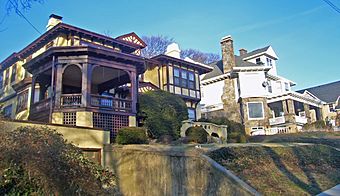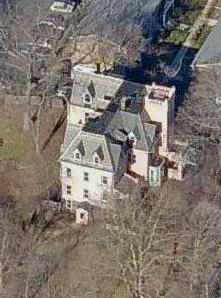Delavan Terrace Historic District facts for kids
Quick facts for kids |
|
|
Delavan Terrace Historic District
|
|

Charles E. Otis and Griffith John houses,
south elevation, 2009 |
|
| Location | Yonkers, NY |
|---|---|
| Area | 4.2 acres (1.7 ha) |
| Built | 1854–1926 |
| Architect | Multiple |
| Architectural style | Late 19th And 20th Century Revivals, Late Victorian |
| NRHP reference No. | 83001827 |
| Added to NRHP | September 15, 1983 |
The Delavan Terrace Historic District is a special area in Yonkers, New York. It's known for its beautiful old houses. This district has 10 historic homes, all built between 1854 and 1926. In 1983, it was added to the National Register of Historic Places. This means it's an important place worth protecting.
Many important business leaders from Yonkers lived here. They enjoyed amazing views of the Hudson River. The houses show off popular building styles from the late 1800s and early 1900s. One house even had a rare Eastlake interior design. The oldest house, the Smith-Collins House, was built in 1854. It was later torn down, which made people work harder to save other historic buildings in Yonkers. Most of the homes in the district were built after 1900.
Famous people once lived on Delavan Terrace. For example, actress Billie Burke lived here in the 1920s. She was a silent film star and later played Glinda the Good Witch in The Wizard of Oz. She lived here after marrying Florenz Ziegfeld, a famous theater producer. Over time, the neighborhood became home to more middle-class families. All the remaining houses are still privately owned, and many look much like they did long ago.
Contents
Exploring Delavan Terrace: What Does it Look Like?
The Delavan Terrace Historic District is shaped like a rectangle. It includes houses on both sides of Delavan Terrace. It also covers the corner lots on Palisade and Park Avenues. The total area is about 4.2 acres (1.7 hectares).
How the Land is Shaped
The street sits on a ridge. This ridge is between the Hudson River to the west and the Saw Mill River to the east. Because of this, the land slopes steeply down to the south and west. The east end of Delavan Terrace is about 50 feet (15 meters) higher than the west end.
What's Around the District?
Around the district, you'll find different types of buildings. To the east and south are large, modern apartment buildings. To the southwest, the land drops sharply to a parking lot. Northwest of the district is another apartment complex. Other houses, usually newer, are to the northeast and east. The whole area is mostly residential. Downtown Yonkers is about a mile (1.6 km) to the south-southwest.
Homes of Delavan Terrace: A Closer Look
All 10 buildings in the district are houses. Each one has its own unique style and history.
- 147 Park Avenue: This house was built in 1908. It's a two-and-a-half-story home with a stucco finish. It's built in the Mission Revival style. It has a porch with a hipped roof and a garage built into the ground.
- Reuben Borland House, 10 Delavan Terrace: Built in 1904, this house is made of stone at the bottom and shingles on top. It has a unique cross-gabled roof. It's a late example of the Queen Anne Style. Look for its many different window shapes and a recessed porch.
- Alexander Denniston House, 6 Delavan Terrace: This house dates back to 1911. It's a two-and-a-half-story home in the Tudor Revival style. It features a recessed porch and projecting gabled sections. You'll see half-timbering in the gable ends, which is typical for this style.
- A. Doty House, 4 Delavan Terrace: This is the newest house in the district, built in 1926. It's a two-and-a-half-story brick building in the neo-Colonial style. It has a slate roof and a fancy main entrance with sidelights.
- William Howard House, 9 Delavan Terrace: Another Queen Anne style home, built in 1904. It has a front porch with decorative ironwork and columns. The original shingle siding has been covered with vinyl.
- Griffith John House, 23 Delavan Terrace: This 1906 Queen Anne house mixes stone on the first floor with vinyl on the upper floors. It has a continuous porch and a bay window.
- E.D. Knap House, 14 Delavan Terrace: Built in 1907, this house shows the Stick style evolving into the Bungalow style. It has shingle siding, a mix of window types, and a recessed porch.
- Law–Baldwin House, 354 Palisade Avenue: This is the oldest house still standing in the district, built in 1886. It's a three-and-a-half-story home in the Shingle Style. It features a continuous porch with columns and an open deck on top.
- Littel House, 149 Park Avenue: This Tudor Revival-style house was built in 1915. It has stucco walls but no half-timbering. It features a cross-gabled roof and a porch with columns.
- Charles E. Otis House, 5 Delavan Terrace: This Tudor Revival house was built in 1904. It has a recessed entrance porch with a pointed arch. You'll see a mix of window types and half-timbering on its stucco walls. The garage is built below ground.
The Smith–Collins House: A Lost Landmark
The Smith–Collins House was once at 323 Palisade Avenue. Built in 1854, it was the oldest building in the district when the area was first recognized. It was a large, two-and-a-half-story house in the High Victorian Gothic style. It was first covered in clapboard and later in stucco.
One of its most striking features was a three-story tower at the corner. It had arched windows and a unique top like a castle. The house also had bay windows and a two-story glassed-in porch at the back. The roof had many gables with decorative trim.
Behind the main house was a carriage house, the only one in the district. It had its original clapboard siding and a small tower on its roof. Inside the main house, there was special Eastlake-style wood paneling and fireplaces. This was one of the few untouched examples of this style in Yonkers.
In 1875, the house was greatly changed. The clapboard was covered with stucco. Some parts, like a covered driveway and the tower's top, were removed. In 2007, both the house and the carriage house were torn down. Only the front wall and gate remain today.
A Journey Through Time: History of Delavan Terrace
The land that became Delavan Terrace was once part of a very large property. Because of this, it was developed later than other areas in Yonkers. But once building started, it happened very quickly.
Early Days: From Pasture to Plots (1693–1853)
For many years, the future Delavan Terrace was just open pastureland. It was part of a huge land grant given to Frederick Philipse by the British king. Even after the Philipse family lost their land during the American Revolution, it remained undeveloped. A later owner, Lemuel Wells, didn't want to sell or divide his land. So, it stayed empty until he died in 1842.
His heirs were more willing to sell the land. By 1843, it was sold and divided into smaller plots. Streets were soon planned and built. Houses started appearing not long after. This process sped up in 1849 when the Hudson River Railroad was built. This brought more industry and growth to Yonkers.
The First Homes Appear (1853–1903)
The first house in the future district was built in 1854 by I.F. Wheeler. It was likely inspired by architect Andrew Jackson Downing. He believed houses should fit in with nature.
In 1873, the land and house were sold to Alexander Smith. He founded the famous carpet mills in Yonkers. Records show the house's value almost tripled. This suggests it was greatly renovated. It changed from an Italianate style to the popular High Victorian Gothic style. It became similar to other grand homes of the time, like Glenview.
It's believed that Alexander Smith's son, Warren Baldwin Smith, lived there. He later moved when he took over the family business. In 1878, the house was sold to Charles Collins. These two owners gave the house its name: Smith-Collins House.
In 1886, another house was built nearby by Walter W. Law. This house was in the Shingle Style, which was very different from its neighbor. Law lived there for only three years. He later became known for developing the village of Briarcliff Manor.
In 1894, the Law house was bought and made larger. The next year, it was sold to William Delavan Baldwin. He was an executive at the Otis Elevator Company. At this time, all the land in the current district was part of his large estate. Baldwin became president of Otis in 1900. Four years later, he divided his property and opened Delavan Terrace for development.
Growing as a Suburb (1904–1926)
By 1910, most of the new street had been developed. The houses showed the latest architectural trends. Many were built in the Tudor Revival or Queen Anne styles. These new homes had less decoration than earlier Queen Anne houses. This showed a move towards simpler designs. The Reuben Borland House, built in 1904, is a great example of a typical middle-class home from this time.
In 1910, the Smith-Collins House changed owners again. A local lawyer, Isidore Beaudrias, bought and renovated it. He covered it in stucco and removed much of its old decorations. These changes made it look more like the newer homes on the street.
Two other early houses brought new styles to the district. The Knap House used the Western Stick Style, which was rare in Yonkers. The house at 147 Park Avenue used the Mission Revival style, popular in California. The Littel House, built in 1915, returned to a simpler Tudor Revival style.
After World War I, more people owned cars. This led to the growth of suburban neighborhoods like Delavan Terrace. Actress Billie Burke found the lifestyle here appealing. She was a silent film star. After marrying producer Florenz Ziegfeld, she focused on stage work. She settled in the Borland House. She liked living a bit away from her work on Broadway in Manhattan.
She reportedly loved the Borland House because it reminded her of her childhood home in London. A reporter described it as "a homey one and a half story red granite and wood structure." She preferred simple interior design, with modest furniture and art.
The last house in the district was built in 1926. The A. Doty House used the neo-Georgian style. This style is known for its balanced look and has remained popular. Like other revival-style houses on the street, it showed its owners' desire for stability.
Protecting History (1927–Present)
For the rest of the 20th century, Delavan Terrace remained a quiet residential street. Owners came and went, but they kept the houses mostly as they were. Some houses got new siding, but this didn't stop the district from being listed on the National Register in 1983.
Things changed slightly in the 21st century. In 2007, the city allowed the Smith-Collins House to be torn down. This event led to efforts to create new laws. These laws would make sure that any demolition of a building over 75 years old would be reviewed. This helps protect Yonkers' historic buildings.
Images for kids






